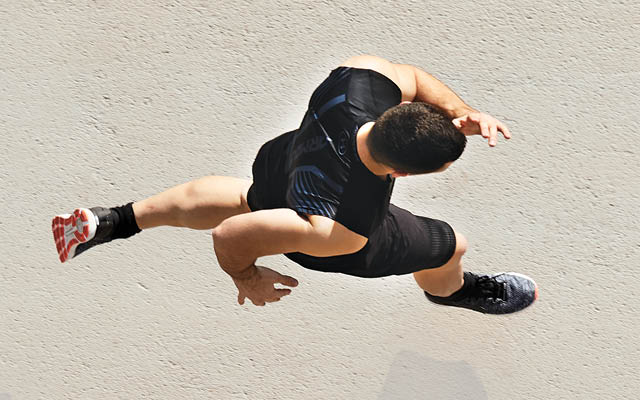A track-and-field athlete at Purdue University in the early 1990s, Doug Sharp knew he was fast – but he might never have learned just how fast if he hadn’t met Loren Seagrave, an internationally recognized track-and-field coach and speed consultant. Seagrave introduced Sharp to over- speed training, which uses aids to literally pull or push athletes to run faster. This type of training teaches the muscles how to move that fast in the future – without the benefit of those pushes or pulls.
After graduation and his service in the U.S. Army, Sharp decided to funnel his speed into the sport of bobsled, and to train with Seagrave for a second time at Velocity Sports Performance, a new facility Seagrave had just founded in Marietta, Ga.
“They’d put me on a treadmill on a decline and crank the speed,” says Sharp, now 36. “I was cooking, going somewhere around 30 miles an hour for short bursts.”
Such high speeds might send an average runner splat against the wall – or to the hospital.
But as a conditioned athlete, Sharp was able to translate the downhill treadmill sprinting into faster speeds and more power. The big payoff arrived in 2002, when Sharp won a bronze medal in the four-man bobsled at the Olympic Winter Games in Salt Lake City.
“With overspeed training, you’re trying to put the body into a gear that it doesn’t normally reach,” explains Ralph Reiff, an athletic trainer and program director of the St. Vincent Sports Performance Center in Indianapolis. “From a physiological standpoint, we’re trying to create a neuromuscular pattern that becomes repetitive enough that it’s not a shock to the body. Overspeed training gets you into the highest level of neuromuscular stimulation, so you become as efficient and effective as you can be in producing speed.”
Methods for Moving Fast
There are three basic overspeed methods: downhill sprinting, mechanized towing, and nonmechanized elasticized harnesses or pulleys.
1. Downhill Sprinting
One of the safest, cheapest and most popular overspeed methods is downhill sprinting, during which gravity pulls you at greater-than-normal speeds. Not all treadmills have a decline option, so coaches often choose a hill with a 1 to 5 percent gradient and then run athletes through up to five repetitions on a 40- to 60-yard stretch. (Doing any more repetitions increases risk of injury.)
“An ideal situation is a 3 percent grade that flattens out at the bottom; athletes can then maintain their faster speed on the flat part,” says Michael Yessis, PhD, the California-based author of Explosive Running: Using the Science of Kinesiology to Improve Your Performance.
The wrong incline, meanwhile, can have detrimental effects on your speed. “If it’s too steep, you’ll start to lean backward, which puts abnormal stress on your heels and calves and ruins the proper biomechanics for top speeds,” says U.S. Olympic women’s track-and-field head coach Sue Humphrey. Functional sports training pioneer Vern Gambetta, who’s worked with pro teams such as the Chicago Bulls and the New York Mets, adds that poor form can also lead to pulled hamstrings.
But when such drills are performed correctly, says Yessis, they will trigger the neurological response for faster speeds – a response the body can call on later. “The muscle has a memory. That is to say, the nervous system learns a pattern,” he says. “When it starts up again, it’s going to duplicate what it was doing, so it’s going to know how to contract much harder and faster than before.”
2. Mechanized Towing
A similar muscle-memory theory applies to mechanized towing methods, which range from the large 1970s-era “sprint master” machines to having coaches in cars pull athletes along behind them. These are some of the most controversial and dangerous overspeed training techniques: Attaching oneself to a car is usually something seen in reality-TV stunts that go horribly wrong, so do not, under any circumstances, try this on your own.
3. Nonmechanized Elasticized Harnesses or Pulleys
Safer, pulley-type towing systems, along with elasticized harnesses, allow athletes and coaches to build velocity on flat ground – without risking life and limb. Attached around the waist or shoulders between two people, such harnesses work like a slingshot. One athlete will run forward, feeling resistance from the elastic band or bungee cord. Then the other athlete or coach will release the band, catapulting the athlete forward. “I’ve seen the most effectual use of overspeed training with harnesses,” says Humphrey. “The harness stretches out as you run, and then, like a rubber band, flings you forward so that you’re going faster than you could normally.”
Will It Work for You?
Because they all help a person move forward in a straight line, sprint-assisted overspeed techniques are best suited for “linear” athletes such as sprinters and football, baseball and softball players, says Gambetta, and less effective for sports involving more lateral movement, such as soccer, basketball and lacrosse.
All athletes should approach overspeed training with caution. Seagrave raises several red flags. “Because it’s a sexy concept,” he says, “some coaches grab onto it and yank all their 10-year-olds down the track.” But novices should steer well clear of overspeed training, which is only suitable for conditioned athletes who have already mastered the mechanics of sprinting.
Among the list of injuries that improper overspeed training can produce are plantar fasciitis, shin splints and Achilles’ tendon injuries, which result from the abnormal pressure placed on the body, especially if an athlete’s form is incorrect. Humphrey adds that there are safer, simpler ways for nonperformance athletes to achieve higher speeds. “Sometimes losing 5 pounds, focusing on form or spending more time in the weight room can make you faster,” she says.
Reiff considers overspeed training “icing on the cake” and says athletes should make it only about 5 to 8 percent of their total workout volume in order to avoid injuries.
While overspeed training isn’t right for everyone, its benefits can catapult a fit few beyond their previous abilities – and, perhaps, right into first place.
How to Sprint Downhill
First, find your ideal slope.
Former Chicago Bulls, Chicago White Sox and New York Mets speed trainer Vern Gambetta prefers a 1 to 2 percent gradient, while Olympic athletic trainer Ralph Reiff recommends a 3 to 4 percent maximum.
The bottom line: Choosing too steep an angle could result in breaking your stride and inviting injuries.
After warming up, run across a flat surface preceding the downhill and then sprint the decline for 40 to 60 yards. Then walk uphill; complete a total of three to five repetitions. “Do it early in the workout,” advises Reiff. “You want to be fresh and well rested.”
This article originally appeared as “Fast Forward” in the October 2006 issue of Experience Life.



This Post Has 0 Comments